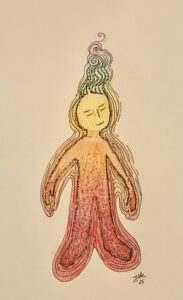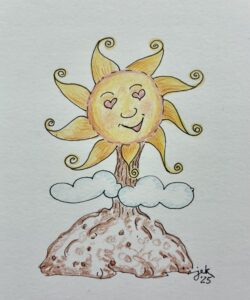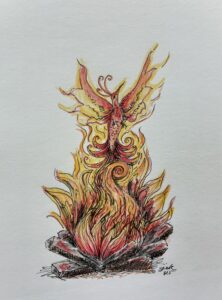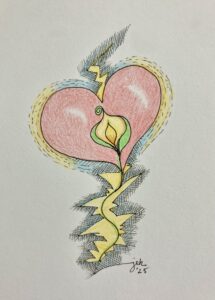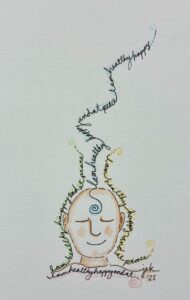
-Artwork © 2025 Jan Ketchel
Thoughts issue from the mental or spiritual plane of our being. Our mind, or spirit, is located in our energy body, or soul, and is intimately connected to, and oversees, all the operations of the physical body. Thoughts have an energetic momentum that profoundly influences our physical body.
Our ego mind, though actually of spirit origin, is so deeply identified with the material world, that it simply cannot believe in the primacy of spirit behind physical life. To entertain this spiritual perspective, as suggested in this blog, suspend temporarily the judgment of the material mind view and open to an insinuation of spirit from your higher mind.
The world is so reflecting to us at this time how rapidly changing thoughts are dismantling and reshaping our material reality. Long held medical, environmental and economic beliefs and truisms are being eliminated with the stroke of a pen. This is a grand scale example of how the force of a spirit, as exercised through thoughts, is reshaping our material world.
The big question is how the material world will carry and sustain the demands of these radically demanding thoughts. As individuals we are equally challenged to contend with the impact of our own thoughts upon our physical bodies.
Spirits choose to enter an earthly life to test out their thoughts in a material playing field. Choice of family and physical circumstance provide the materials to mold a physical life to embody the thoughts it seeks deeply to explore through a human life. Our physical lives are thus our spirit’s laboratory for discovery and growth. Spirits may actually need a physical life to advance in their more subtle dimensions of existence.
For a spirit who lacks the experience of emotional attachment and the maturation and refinement of love needed to advance on its spiritual plane of existence, an earthly life in time, space and the dense energy of physical relationships can provide all the necessary materials for advancement.
As a spirit works its way through the developmental stages to mature love in physical form, it will materialize or attract to it a plethora of relationship experiences to refine its experience of love and relationship from its crudest to its most sublime form. This subtle energetic achievement of refined love will allow it to deepen its spiritual horizons in infinity.
Of course the truth is that we need spirit to advance our life in physical form as well. Spirit, or the mind, generates the thoughts whose substance builds the body. Yes, we build muscle and physical skill through physical exercise and repetition, but we equally generate those physical results through their repetition in the imagination. This is the action of suggestion from the conscious to the subconscious mind. It is the subconscious mind that materializes spirit intent.
Not only are our bodies shaped by our own thoughts but also by the thoughts of others who are attracted to our thoughts and moods. If we are burdened with our own negative thoughts and absorb the negative thoughts of others, our bodies, the physical representatives of those thoughts, will reflect the weight of those burdens upon our slumped shoulders and the sad, depressed feelings impressed upon our wrinkled brows.
In order to replenish our bodies we must allow for new thoughts to saturate our minds. May these new thoughts be for the greater good of self and other. Like attracts like. When we bathe in positive, loving thought, we magnetize our energy to draw to us people, circumstances and outside thoughts that reflect our state of mind. This also has the effect of detaching us from others whom we may have attracted from our prior negativity. Thoughts, people and spirit entities drop away when they find no sustenance in our current positive thinking.
Of course, we must contend with the ruts of old thoughts that have been habitually stored in the automatic functioning of the subconscious mind. These habits are the triggers associated with old thoughts. The good news is that the subconscious is always open to suggestions in the form of spirited new thoughts.
However, before the subconscious abandons an old directive it will test your resolve and patience through seeing your reaction to old triggers. Don’t get caught. Prove your sincerity. Firmly tell the old thought to get lost, but most importantly, emphatically and often, state the new thought. And then, with unswerving faith in the power of one’s new thought, calmly follow its yellow brick road to completion.
Try this one: My body reflects my spirit. My spirit is completely healthy, wealthy and wise. My deepest spiritual desires are realized in human form. Everything is possible.
Chuck

